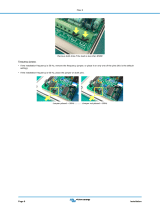
33
33
3
ContentsContents
ContentsContents
Contents
1.1.
1.1.
1.
IntroductionIntroduction
IntroductionIntroduction
Introduction
........................................................................................................................
........................................................................................................................
............................................................
5 5
5 5
5
1.1 Package Contents..................................................................... 5
1.2 Specifications ........................................................................... 6
1.3 Motherboard Layout ................................................................. 10
1.4 I/O Panel .................................................................................... 11
2.2.
2.2.
2.
InstallationInstallation
InstallationInstallation
Installation
............................................................................................................................
............................................................................................................................
..............................................................
12 12
12 12
12
Pre-installation Precautions ............................................................... 12
2.1 CPU Installation ......................................................................... 13
2.2 Installation of CPU Fan and Heatsink ....................................... 13
2.3 Installation of Memory Modules (DIMM).................................... 14
2.4 Expansion Slots (PCI, AMR and AGP Slots) ............................. 15
2.5 Jumpers Setup.......................................................................... 16
2.6 Onboard Headers and Connectors.......................................... 18
2.7 Driver Installation Guide ............................................................ 21
3.3.
3.3.
3.
BIOS SBIOS S
BIOS SBIOS S
BIOS S
ETUP UTILITYETUP UTILITY
ETUP UTILITYETUP UTILITY
ETUP UTILITY
......................................................................................................
......................................................................................................
...................................................
22 22
22 22
22
3.1 Introduction ............................................................................... 22
3.1.1 BIOS Menu Bar ............................................................... 22
3.1.2 Navigation Keys ............................................................. 23
3.2 Main Screen.............................................................................. 23
3.3 OC Tweaker Screen................................................................. 24
3.4 Advanced Screen .................................................................... 26
3.4.1 CPU Configuration .......................................................... 27
3.4.2 Chipset Configuration..................................................... 28
3.4.3 ACPI Configuration ......................................................... 29
3.4.4 Storage Configuration .................................................... 30
3.4.5 PCIPnP Configuration ...................................................... 32
3.4.6 Floppy Configuration ...................................................... 33
3.4.7 Super IO Configuration................................................... 33
3.4.8 USB Configuration.......................................................... 35
3.5 Hardware Health Event Monitoring Screen ............................. 36
3.6 Boot Screen.............................................................................. 36
3.6.1 Boot Settings Configuration ........................................... 37
3.7 Security Screen........................................................................ 38
3.8 Exit Screen ............................................................................... 39























